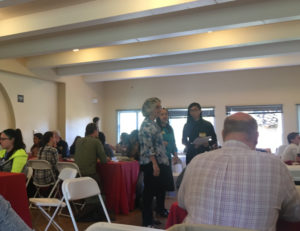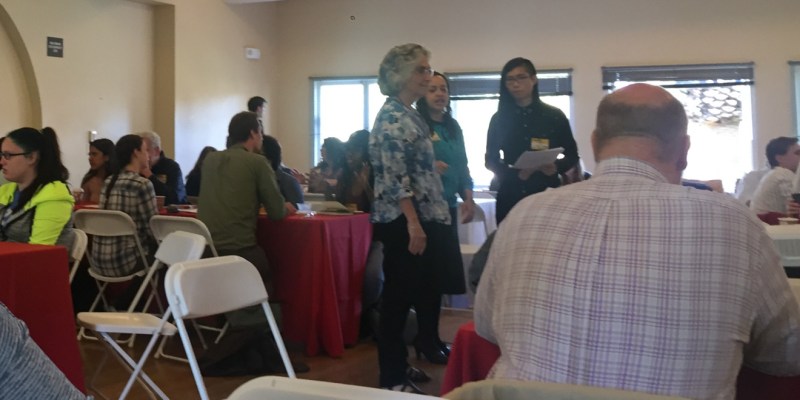On Saturday, Provost Persis Drell sought to increase University transparency by facilitating a day-long event on institutional change with Lily Zheng ’17, a vocal advocate for campus activism.
The event consisted of morning sessions that explained elements of Stanford’s institutional structure and then a workshop portion in which attendees collaborated in small groups to brainstorm strategies for institutional change within specific topics. Over 50 people attended, including undergraduates, graduate students, administrators and faculty.
Why now?
When Drell became provost in February of this year, Zheng, a Daily staffer, saw a unique opportunity to change the tone of the dialogue between students and administrators.
Zheng described the early days of her activism at Stanford as a time when tensions between administrators and students were heightened to the point that she felt like a “freedom fighter” pitted against an evil administration.
From those “thrilling” but conflict-laden days, Zheng said she learned that activism has to take advantage of institutional knowledge to be effective.
According to Zheng, the infrastructure of the University is surprisingly decentralized. Observing a complex interplay between departments, deans, provosts and other administrators, she felt that it was fundamental for Stanford students to understand how the University operates in order to know how to strategically achieve their goals.
Zheng recognized the opportunity to provide students with this knowledge with Drell’s appointment and quickly began discussions with Drell to discuss the best way to improve institutional transparency.
“We had the idea of [this event as] a place where information about Stanford’s institutional structure, governance structure and organizational structure could be put on the table in a way that I don’t think has been done before,” Zheng said.
Zheng was pleased to find that Drell was receptive to discussions about increasing University transparency.
“As dean of engineering, making things more transparent was important,” said Drell, who served as dean before being appointed provost. “So it’s a natural part of my management style.”
She added that as a new provost, her process of learning about the University inherently requires openness.

Morning sessions
In her opening comments at Saturday’s event, Drell emphasized the importance of cultivating change-makers and arming them with the tools to interact with the University.
“Complacency is always a real danger at big institutions,” she said.
Drell also discussed the need to understand how change really happens: For instance, she said that it is important to recognize the disconnect between the myth of the isolated, powerful leader spearheading change and the reality of teams of motivated people collaborating to cause policy shifts.
The speaker sessions that followed emphasized the value of linking institutional knowledge with passion for change. Sessions were recorded so that more people could benefit from the institutional framework that the speakers elucidated.
One lecture outlined relevant parts of University history and structure and detailed the responsibilities of different members of the University, such as the Board of Trustees and deans.
Another exercise put forth three hypothetical situations — such as hiring a president — so that facilitators and attendees could talk through which parts of the University have the greatest influence in each process. Drell, as well as others facilitating the event, emphasized that members of Stanford’s highest hierarchical level are often not the people who are most knowledgeable and influential in specific University processes.
Workshop
For the workshop section, attendees split into small groups and tackled specific goals within four broad change agendas: introducing a new course requirement for freshmen, achieving gender parity in faculty by 2025, creating a new themed dorm and creating a more inclusive department culture.
“We picked problems that we think are complicated and nuanced — problems that we felt didn’t have a clear answer,” Zheng said.
Groups were guided by other community members acting as coaches through a planning process that included identifying stakeholders and making goals month by month. After over an hour of discussion, groups came together to reflect on the progress they made and the obstacles they faced.
Anna Widder ’19 said that one of the most valuable aspects of the event was discovering how quickly an idea can arise and be developed within a workshop setting. As she learned more about the power structure of the University and worked through the steps of the planning process, she gained a greater understanding of her potential to enact change.
“We were working on a new themed dorm, and it seems like it’s very possible,” Widder said. “I think that going through the motions was really helpful.”
A common difficulty for group members was identifying the faculty members who would be allies for their causes and brainstorming ways to persuade others of the importance of their mission — problems that coaches said were not easily solved.
Drell said she was eager to hear more feedback on how to improve the event but was impressed with the quality of discussions and plans. She hoped that students would consider developing their ideas and submitting proposals to the University’s long-range planning process, which will map out Stanford’s vision for its future.
“There were some great suggestions here today,” Drell said.
Contact Claudia Heymach at cheymach ‘at’ stanford.edu.
